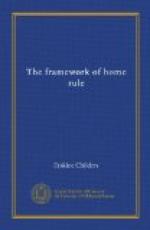energy, he insisted on and worked for a settlement
by consent, with a formal promise of future self-government
to the Boers. In this he was in sharp opposition
to Lord Milner, who desired to extort an unconditional
surrender. Of these two strong, able, high-minded
men, the soldier, curiously enough, was the better
statesman. In temperament he recalls the General
Abercromby of 1797 on the eve of the Irish rebellion,
still more perhaps General Carleton, who administered
French Canada in the critical period after its conquest
and during the American War. Lord Milner, in
political theory, not in personality, corresponds
to Fitzgibbon. His view was that British prestige
and authority could only be maintained in the future
by thus humbling the national pride of our adversaries,
who, moreover, by the formal annexations of 1900,
carried into effect when the war was still young,
were by a legal fiction rebels, not belligerents.
Lord Kitchener, besides seeing, as the responsible
soldier in the field, the sheer physical impossibility
of lowering the Boer national pride by any military
operations he had the power to undertake, from the
beginning of the guerilla war onwards, was a truer
judge of human nature and a better Imperialist at
heart in realizing that the self-respect of the Boers
was a precious asset, not a dangerous menace to the
Empire, and that the whole fate of South Africa depended
on a racial reconciliation on the basis of equal political
rights, which would be for ever precluded by compelling
the Boers to pass under the Caudine Forks.
Fortunately Lord Kitchener was supported by the Home
Government, and the Peace of Vereeniging took the
form of a surrender on terms, or, virtually, of a
treaty, formally guaranteeing, among other things,
the concession “when circumstances should permit”
of “representative institutions leading up to
self-government.” The next ordeal of British
statesmanship came when the time arrived in 1905 to
redeem this promise. There were two distinctly
defined alternatives: one, to profit by experience
and to give responsible government at once; the other,
for the time being, to copy one of the constitutional
models which had long been obsolete curiosities in
the history of all the white Colonies, which had never
failed to produce mischievous results, whether in a
bi-racial or a uni-racial community, and which were
in reality suited only to groups of officials and
traders living in the midst of uneducated coloured
races in tropical lands. The Government, and we
cannot doubt that their traditional policy toward Ireland
warped their views, declared for the latter alternative,
and issued under Letters Patent a Constitution which
happily never came into force. Like the Act of
Union with Ireland, it gave the shadow of freedom without
the substance. It set up a single Legislative
Chamber, four-fifths elective, but containing, as
ex-officio members, the whole of the Executive
Council as nominated by the Crown. Executive power,




